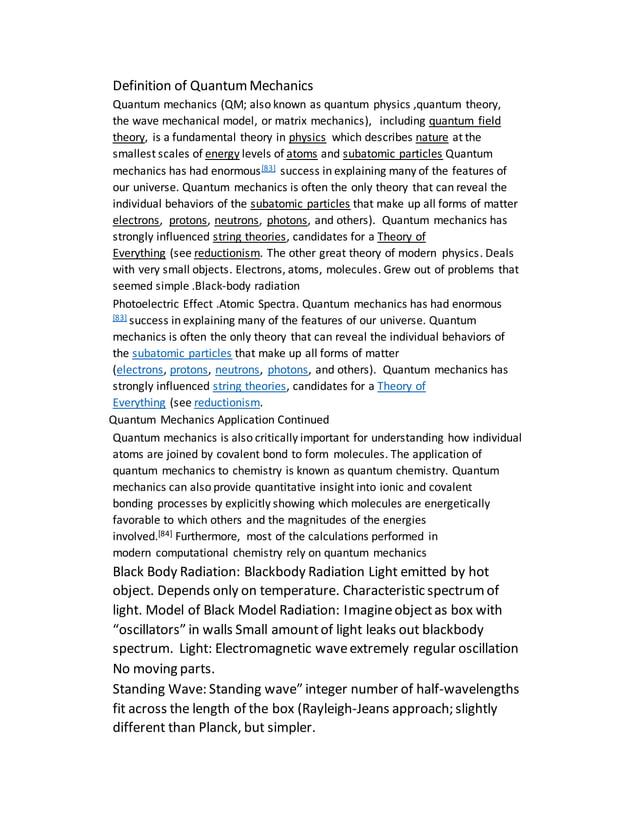Quantum mechanics is often heralded as one of the most intriguing yet confounding realms of modern physics. But what is a very basic definition of quantum mechanics? Are we not led to ponder the enigma of existence itself—a playful question that begs exploration, reflects our innate curiosity, and exposes a potential challenge for every aspiring physicist? To embark on this inquiry, we must contemplate the fundamental principles that govern the quantum world.
At its core, quantum mechanics is the branch of physics that deals with phenomena occurring at the atomic and subatomic levels. Traditional classical mechanics, which governs the behavior of macroscopic objects, fails to account for the unique behaviors observed in particles like electrons and photons. Thus, the definitional essence of quantum mechanics distinguishes itself by emphasizing discrete energy levels, wave-particle duality, and inherent uncertainties.
To detail further, we encounter the concept of quantization, which posits that certain properties, such as energy, can only assume specific values, akin to musical notes on a scale rather than continuous sound. Quantum mechanics stipulates that energy is quantized into packets called quanta, which fundamentally alters our understanding of energy transfer and interaction. This leads us to the corresponding notion of wave-particle duality, which asserts that particles exhibit both wave-like and particle-like characteristics. This duality challenges conventional logic and invites a rich tapestry of philosophical implications.
At the heart of quantum mechanics lies the wave function, an abstract mathematical construct that encapsulates the probabilities of a quantum system’s possible states. This is where things become even more tantalizing. Upon measurement, the wave function collapses to reveal a definite outcome from the range of possibilities, thus introducing the concept of superposition. Prior to measurement, a particle such as an electron may exist in multiple states simultaneously, rather like Schrödinger’s famous cat that is simultaneously alive and dead. Is it mere whimsy, or does such a scenario lay the groundwork for the fundamental nature of reality itself?
The Heisenberg uncertainty principle further complicates our understanding by arresting the classical notion of determinism. According to this principle, one cannot precisely measure both the position and momentum of a particle simultaneously. The more accurately one is known, the less certain the other becomes. This intrinsic uncertainty imbues quantum mechanics with a philosophical air, rendering the very act of observation a participant in the phenomenology of the quantum realm.
Additionally, consider the implications inherent in quantum entanglement, whereby particles become interlinked in such a way that the state of one particle instantaneously affects another particle, regardless of the distance separating them. This phenomenon, which Einstein famously derided as “spooky action at a distance,” defies classical intuitions about locality and causality. From a definition standpoint, entangled particles are a testament to the interconnectedness of the quantum world—a stark contrast to the isolated interactions prevalent in classical physics.
Upon delving into various interpretations of quantum mechanics, we encounter a legion of philosophical frameworks, leading to a plethora of unresolved questions. The Copenhagen interpretation, widely regarded as the orthodox viewpoint, argues that the wave function collapses upon observation, yet it does not seek to elucidate the nature of the observer’s role. Conversely, the Many-Worlds interpretation posits that every possible outcome of a quantum event actually occurs, resulting in a branching multitude of parallel universes. This interpretation indeed leads us back to our initial playful inquiry: Do we inhabit one reality, or are we mere wanderers in a multiverse of possibilities?
In summary, the very basic definition of quantum mechanics is that it is a foundational theory that governs the complex and often unintuitive behavior of matter and energy at the smallest scales. It encapsulates key concepts such as quantization, wave-particle duality, superposition, uncertainty, and entanglement—all of which challenge our preconceived notions of how the universe operates. The realm of quantum mechanics invites us to embrace the uncertainties, revel in the paradoxes, and ponder the rich tapestry of existence, leading to ever deepening questions without clearly defined answers.
Ultimately, as we navigate the landscapes of both quantum mechanics and reality, we may grapple with the realization that our understanding is ever-evolving, rendering even the simplest definitions subject to the vast complexities woven into the fabric of existence. Thus, while we may arrive at a fundamental definition, the journey through quantum mechanics remains a cerebral adventure filled with profound questions and remarkable revelations.












